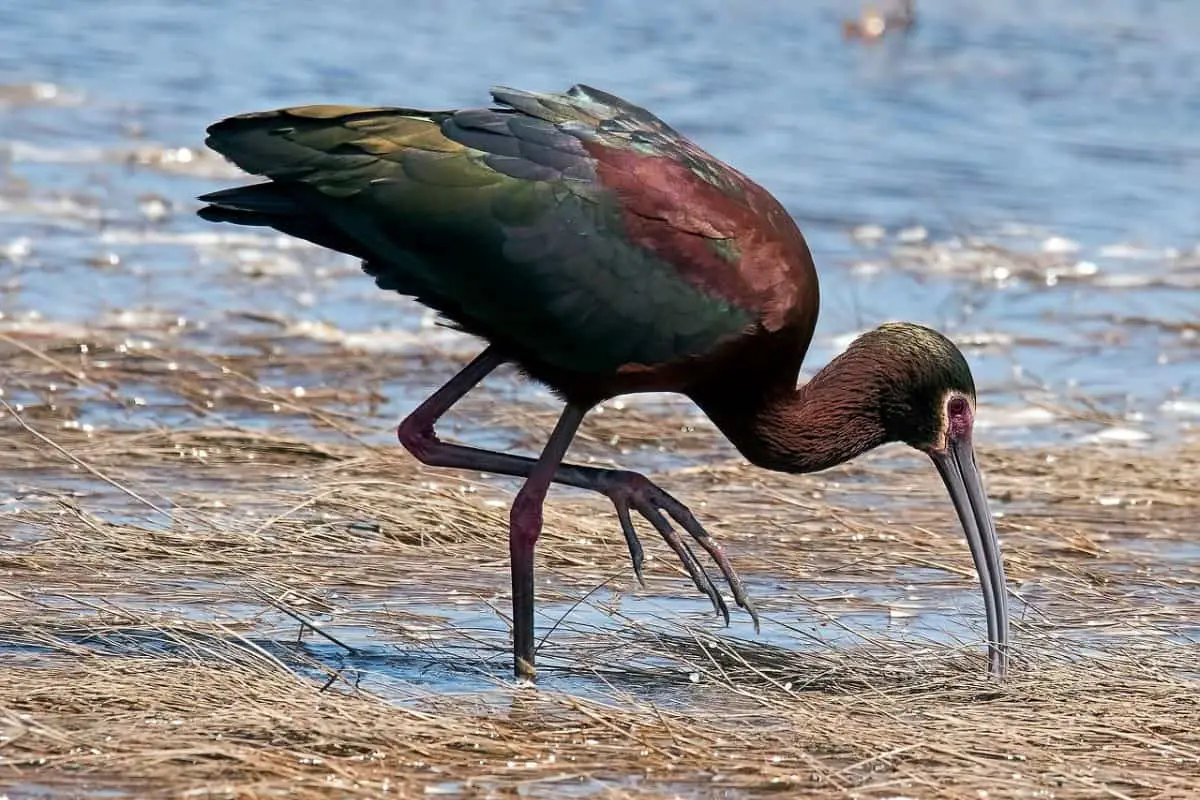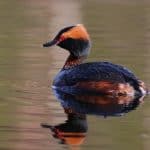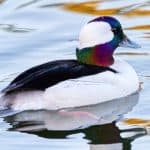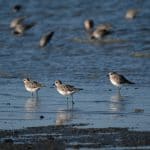Common Name: White-faced Ibis
Scientific Name: (Plegadis chihi)| Size | Diet | Range in Hawaii | Status in Hawaii |
|---|---|---|---|
| 22 in. - 27 in. | insects, crustaceans, and aquatic invertebrates | Kaua'i, O'ahu, Moloka'i, Maui, and Big Island | Least Concern |
The White-faced Ibis (Plegadis chihi) is a striking and unique bird species that is known for its distinctive white face and long, curved bill. With its elegant plumage and graceful movements, this ibis is a fascinating sight in its natural habitat.
Although it is not a native species to Hawaii, White-faced Ibises have been spotted occasionally on the islands as non-breeding visitors, making for a rare and exciting sighting for birdwatchers. In this article, we’ll explore the fascinating world of the White-faced Ibis and learn more about its occasional presence in Hawaii.
White-faced Ibis
Appearance
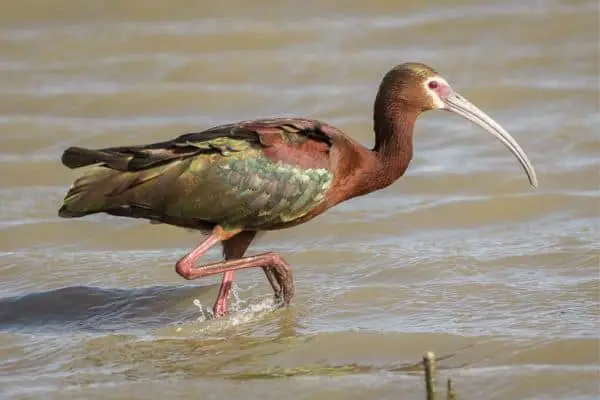
The White-faced Ibis is a medium-sized bird with distinctive features. It measures approximately 22 to 27 inches (56 to 69 centimeters) in length, making it a relatively compact ibis species.
The plumage of the White-faced Ibis is predominantly dark with iridescent hues. The overall coloration ranges from deep maroon to dark brown, with a glossy sheen that can appear purplish or greenish in certain lighting conditions. The feathers on its back and wings have a metallic luster, contributing to its striking appearance.
One of the key distinguishing features of the White-faced Ibis is its white or pale blue facial skin, which contrasts with its dark plumage. This pale skin extends from the base of the bill, covering the lores (the space between the bill and the eyes) and the area around the eyes. This feature gives the species its name.
The White-faced Ibis has a long, downward-curving bill that is slender and slightly decurved. The bill is dark in color, often blackish or grayish, and is used for probing in mud or shallow water to capture its prey.
In terms of body shape, the White-faced Ibis has a relatively long neck and legs, which aid in its foraging behavior. Its legs are typically a shade of reddish-brown, blending with the overall coloration of its plumage.
Diet
The White-faced Ibis has a diverse and adaptable diet. As a wading bird, it primarily feeds on small aquatic creatures found in wetland habitats. Its diet consists of various invertebrates and small vertebrates.
The primary food source for White-faced Ibises is invertebrates such as insects, crustaceans, and aquatic invertebrates like snails and worms. They use their long, slender bills to probe the soft mud or shallow water, searching for prey. They may also use tactile sensation or visual cues to detect their food.
Insects, including beetles, grasshoppers, dragonflies, and aquatic insect larvae, form a significant part of their diet. They can also feed on small fish, frogs, tadpoles, small crustaceans, and other small aquatic organisms. Occasionally, they may consume plant matter, seeds, and grains.
White-faced Ibises are highly opportunistic feeders and adapt their diet based on the availability of food in their wetland habitats. They forage individually or in small groups, often in shallow water or wetland areas with soft substrates.
These ibises employ various feeding techniques, including probing their bills into the mud, sweeping their bills from side to side, or using a tactile touch-and-grasp method to capture prey. They may also employ visual hunting strategies, monitoring the water’s surface for movement or actively pursuing prey that is in motion.
Nesting
White-faced Ibises engage in colonial nesting, often forming large colonies alongside other waterbirds. They select nesting sites in wetland habitats such as marshes, swamps, and reed beds, usually close to a reliable water source.
The breeding season for White-faced Ibises varies depending on the location, typically occurring from late spring to early summer. During this time, the ibises engage in courtship displays to establish pair bonds and select suitable nesting territories.
The nests of White-faced Ibises are constructed using vegetation materials, including reeds, grasses, and twigs. Both male and female ibises participate in nest building, with the female taking the lead in arranging the materials.
The nests are usually situated in dense vegetation, elevated above the water or on sturdy platforms created by accumulated plant debris. The structure is typically a loose platform or bowl shape, with a shallow depression in the center to cradle the eggs.
A female White-faced Ibis usually lays a clutch of three to five eggs, although clutch size can vary. The eggs are oval-shaped and have a pale green or blue-green color. Both parents take turns incubating the eggs, which lasts for about 21 to 23 days.
Once the eggs hatch, both parents are involved in the care and feeding of the chicks. The chicks are altricial, meaning they are initially helpless and rely on their parents for warmth and food. The parents regurgitate partially digested food to feed the chicks until they are capable of foraging on their own.
The nesting colonies of White-faced Ibises can be quite noisy and bustling with activity as adults come and go, chicks beg for food, and various waterbird species interact. These colonies offer protection against predators and provide opportunities for social interactions and communal defense.
Behavior

White-faced Ibises are highly social birds and often gather in large flocks, both during migration and in their breeding and foraging habitats. They are known to form mixed-species flocks with other waterbirds, such as herons, egrets, and other ibis species.
These ibises are primarily diurnal, being active during the daytime and resting or roosting at night. During the day, they engage in various activities, including foraging, preening, socializing, and nesting.
Foraging is a vital behavior for White-faced Ibises, and they have specialized feeding techniques. They use their long, curved bills to probe the soft mud or shallow water, searching for prey.
They may sweep their bills from side to side or use a tactile touch-and-grasp method to capture small aquatic creatures. Whit-faced ibis can often be observed foraging both individually and in small groups.
White-faced Ibises also engage in courtship displays during the breeding season to attract mates and establish pair bonds. These displays involve various behaviors such as head-bobbing, bill-pointing, wing-fluttering, and vocalizations. Males may perform elaborate flight displays to showcase their plumage and courtship abilities.
During nesting, White-faced Ibises exhibit communal behavior by forming breeding colonies alongside other waterbirds. These colonies provide safety in numbers and opportunities for social interactions. Within the colony, ibises engage in territorial defense to protect their nesting territories and offspring from intruders.
Vocalizations play a significant role in communication among White-faced Ibises. They emit a variety of calls, including grunts, croaks, squawks, and guttural sounds. These vocalizations serve various purposes, such as maintaining contact within the flock, expressing alarm or aggression, and during courtship rituals.
White-faced Ibises are migratory birds, with some populations undertaking long-distance seasonal migrations. They navigate using visual cues, landmarks, and celestial cues, relying on their innate navigational abilities to reach their desired destinations.
Habitat
The White-faced Ibis is a bird species that is primarily associated with wetland habitats. They are commonly found in freshwater and brackish marshes, swamps, flooded fields, and shallow wetlands throughout their range.
These ibises are adaptable and can inhabit a variety of wetland environments, including both natural and man-made habitats. They are known to frequent areas with standing or slow-moving water, such as the edges of lakes, ponds, rivers, and marshes.
Vegetation plays an important role in the habitat of White-faced Ibises. They are often found in areas with dense emergent vegetation, such as cattails, bulrushes, reeds, and other marsh grasses. These dense plant communities provide cover for nesting, protection from predators, and suitable foraging opportunities.
White-faced Ibises are highly adaptable to different climates and can be found in a range of geographic regions. They are native to the Americas and occur from the southwestern United States, through Central America, and into parts of South America. Within their range, they can inhabit a variety of wetland habitats, from coastal marshes to inland wetlands.
Range
In Hawaii, White-faced Ibises have been observed on various islands, including Kaua’i, O’ahu, Moloka’i, Maui, and Big Island. Sightings of White-faced Ibises have occurred since the late 1800s and have continued through recent years.
Notable incursions and extended sightings of White-faced Ibises have been recorded, with some individuals remaining in Hawaii for up to 10 years. While there has been speculation about their breeding in the state, no direct evidence has been obtained to confirm this.
Conservation Status
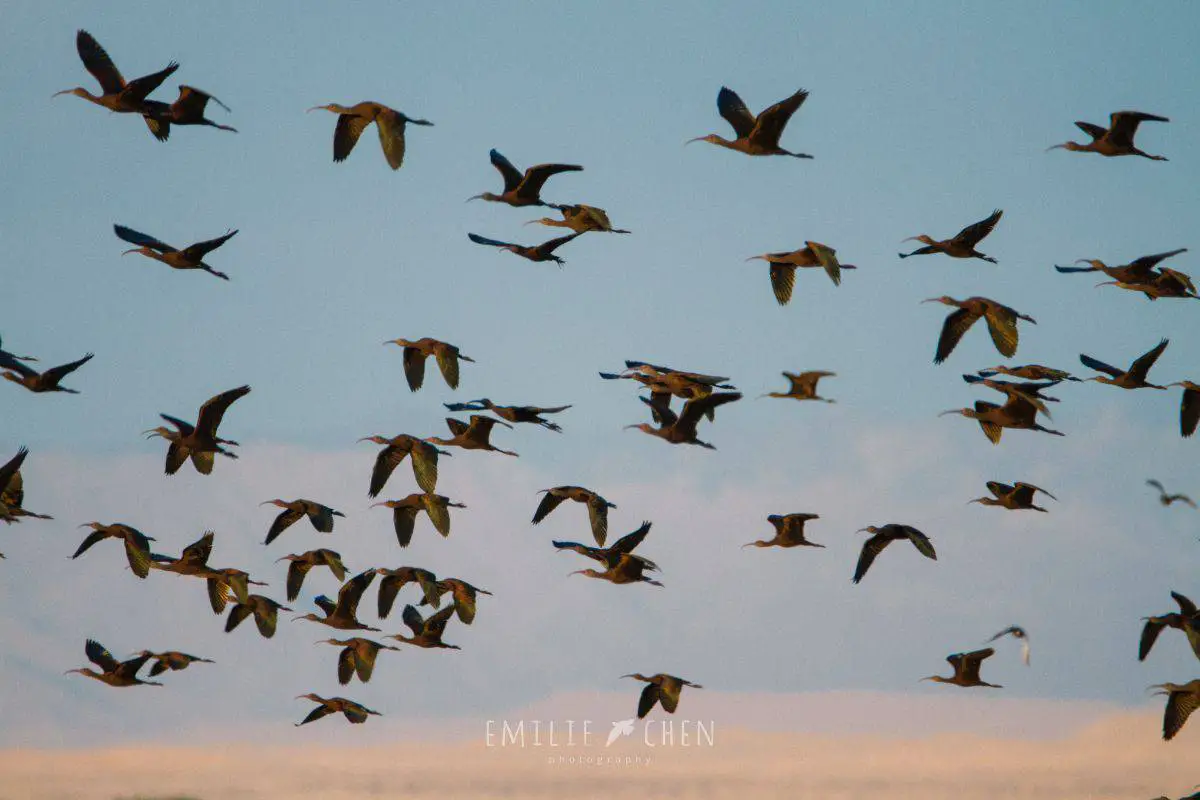
The conservation status of the White-faced Ibis is generally assessed as being of least concern. While the species as a whole is not currently considered threatened, it does face some conservation challenges.
The White-faced Ibis has a relatively large population and a wide distribution range that spans from the southwestern United States to parts of South America. This broad range provides some level of resilience and stability for the species.
Interesting Facts
1. Distinctive facial features
The White-faced Ibis is named for its unique white face, which contrasts with its dark body and glossy iridescent feathers. During the breeding season, the face turns bright red, adding to its striking appearance.
2. Navigational abilities
White-faced Ibises have remarkable navigational skills. They rely on celestial cues, landmarks, and their innate sense of direction to navigate during their long-distance migrations.
3. Specialized feeding technique
These birds have a unique feeding method called “probing.” They use their long, curved bills to probe into the soft mud or shallow water, feeling for prey items such as insects, crustaceans, and small fish.
4. Flexible foraging behavior
White-faced Ibises adapt their foraging behavior to suit the available food sources. They can be seen foraging individually or in small groups, employing various feeding techniques to capture their prey.
Frequently Asked Questions
1. How long do White-faced Ibises live?
White-faced Ibises have a lifespan of approximately 10-15 years in the wild. Factors such as predation, habitat quality, and overall health can influence their longevity.
2. Are White-faced Ibises social birds?
Yes, White-faced Ibises are highly social birds. They often gather in flocks during migration and form breeding colonies, where they engage in social interactions, territorial defense, and communal nesting behavior.
3. How do White-faced Ibises communicate with each other?
White-faced Ibises communicate through a variety of vocalizations, including low croaks and guttural calls. These vocalizations are used for various purposes, such as establishing territory, attracting mates, and maintaining group cohesion.
4. Are White-faced Ibises territorial?
White-faced Ibises can be territorial during the breeding season. They defend their nesting territories and engage in aggressive displays and vocalizations to ward off intruders or competing individuals.
